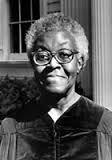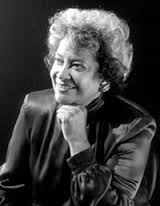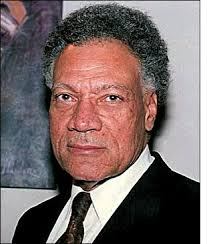|
On June 7, 1917 in Topeka, Kansas the great Gwendolyn Brooks was born. She was the first child of David and Keziah Brooks. At just six weeks old, during the great migration, her family moved to Chicago, Illinois. During her grade school career Gwendolyn attended three different high schools Hyde Park a top white high school, Wendell Phillips an all-black school, and Englewood High School. She also began her career as writer and published her first poem “Eventide”, which was published in American Childhood Magazine. This feat was accomplished by the age of 13. Gwendolyn was highly influenced by James Weldon Johnson and Langston Hughes, after meeting them she was encouraged to read modern poetry and write every day. Within the next three years she published at least 100 poems as an adjunct member of the Chicago Defender. After graduating high school she attended Wilson Junior College, which she graduated in 1936. Her early school experiences helped mold her into a great writer. In 1938 Gwendolyn became involved with a group of writers who wrote for Harriet Monroe’s still-extant Poetry: A Magazine of Verse, she also married Henry Blakely and by 1951 they had two children, Henry, Jr. and Nora. In 1943 she won the Midwestern Writers Conference Poetry Award. In 1945 she became an award winning author with her first book of poetry, A Street in Bronzeville, which immediately brought her critical acclaim and she was later selected as one of Mademoiselle Magazine’s “Ten Young Women of the Year”. She also won her first Guggenheim Fellowship, and became a fellow of the American Academy of Arts and Letters. In 1949 she published her second book of poems, Annie Allen, which won Poetry Magazine’s Eunice Tietjens Prize. In 1950 she received the Pulitzer Prize and became the first African America to win the award. Gwendolyn continued to pile up awards until she died; she even managed to receive an honorary degree as Doctor of Humane Letters. In 1962 Gwendolyn Brooks was invited to read at a Library of Congress poetry festival by President John F. Kennedy. Later in 1985 she was appointed poetry consultant to the Library of Congress. In 1994 Gwendolyn was selected by National Endowment for the Humanities as the Jefferson Lecturer; this award is the highest award given by the Federal Government in humanities. She began teaching in 1963 at a poetry workshop at Columbia College in Chicago, Illinois. She also taught creative writing at a plethora of schools such as; Northeastern Illinois University, Elmhurst College, Columbia University, Clay College of New York, and the University of Wisconsin. In 1967 Brooks awakened the activist in her business life and in her personal life; she attended the Second Black Writers’ Conference and was inspired to become a part of the Black Arts Movement. She became a visible and powerful ally for the Black Arts Movement; she also broke loose from major publishing companies to black owned publishing companies. Critics say her writing also took on a different tone as she became more of a leader in the movement. Gwendolyn died December 3, 2000 of cancer in Chicago, Illinois. She was a dedicated Chicagoan, writer and champion for African equality in the Arts. Gwendolyn was a success from her first piece of writing until her death. Miss Gwendolyn Brooks, we stand on your shoulders. J.A. Ward. Click below to view the Gwendolyn Brooks video
0 Comments
On April 17, 1957 Kevin Donovan was born in the South Bronx, New York, to a family of socially conscious people. His mother and his uncle were active within the black liberation movement of the 1960’s. Donovan was exposed to ideas and tactics used to obtain freedom for the people of the African diaspora. Donovan was also exposed to the South Bronx gang culture. He was a member of the Black Spades, a gang in which he was a leader. Under his leadership the gang flourished throughout the city displaying his natural abilities. As a teen Donovan earned a trip to Africa by winning an essay contest. This trip to Africa would change this young man’s life forever. Donovan was inspired by the Zulu of South Africa. He was most impressed with the Chief of the Zulu Bhambatha. He marveled at the unity and the community Chief Bhambatha built with his leadership. Soon after his trip to Africa, Donovan changed his name to Afrika Bambaataa Aasim. He also became a part of the change within his neighborhood. He created an organization called The “Bronx River Organization.” This organization was designed to build up the neighborhoods instead of tearing them down. Bambaataa also begin hosting parties in 1977 which were designed to spread love and unity through the neighborhoods. These parties were some of the early scenes where the Hip-Hop music grew out of the culture of the South Bronx. DJ Kool Herc and Grandmaster Flash were some of the early pioneers credited with creating the music of Hip-Hop. Afrika Bambaataa is credited with naming and defining the culture of Hip-Hop. In 1982 Bambaataa and his band of performers traveled outside of the United States on a Hip-Hop tour. This tour was just what Bambaataa needed to help him spread Hip-Hop and its messages around the world. He would later create two new Hip-Hop groups the Jazzy 5 and the Soulsonic Force. As a member of The Soulsonic Force Bambaataa and his crew released a groundbreaking song “Planet Rock” which helped change Hip-Hop forever. Bambaataa would later change the name of The Soulsonic Force to the Universal Zulu Nation as he continued to spread Hip-Hop across the world. Hip-Hop was used to unite the neighborhoods of the South Bronx helping them build their community. Bambaataa was also using the music to unite the world. He used his influence and resources to help within the Anti-apartheid movement of South Africa and the Stop the Violence movement in America. He released 22 albums and appeared on various soundtracks and song features. Afrika Bambaataa found a way to change his negative energy and outlook into a positive one. Because of the efforts of Bambaataa and other Hip-Hop pioneers the music and culture of Hip-Hop has spread worldwide. Bambaataa’s song “Planet Rock” is considered one of the greatest songs of all time. “Planet Rock” proved that one could have fun, dance, and shut the party down all while uplifting their community. Africa Bambaataa Aasim, we stand on your shoulders. J.A. Ward. Click below to view the Afrika Bambaataa video On April 15, 1928 Norma Merrick Sklarek was born in Harlem, New York to parents who were raised in the West Indies. As a child she was labeled as a bright and creative person. Her father instilled the idea of greatness no matter what her field of choice was. Her brilliance as a child would lead her to attending and graduating from Hunter High. This was an all-girls magnet school for the smartest girls in New York City. Early in Life she developed a love for art, science and math; these subjects are the foundation of architecture. After graduating high school she attended Barnard College for a year; she would then enroll in Columbia University’s School of Architecture. Sklarek was able to beat the odds because Columbia University’s Architect School only accepts a small number of women each year. While earning her degree in Architecture, Sklarek continuously amazed her peers and professors by displaying her brilliance and skill. She was one of the few students to pass the Architecture exit exam in one try, in the history of Columbia University. After Graduation she faced some roadblocks looking to start her career as an architect. Sklarek found it difficult to land a job working for a private architecture firm, so she began working for The Department of Works in New York City. Though Sklarek was happy to have a job, working for the City of New York was not her dream. Her dream was to become an architect so she stuck to her dream and quit her job. Her next step was looking for a job within the architecture field which took time but she eventually found a job. She gained employment with Skidmore, Owings and Merrill, which is a well renowned architecture firm in New York. Sklarek worked with Skidmore, Owings and Merrill for four years before she left New York for Los Angles. After moving to Los Angles Sklarek was able to find employment with Gruen Associates. Working for Gruen Associates was a dream that came true for Sklarek. She was able to find success within the field of architecture as well as build a name for herself. In 1966 Sklarek was named director of Gruen Associates and the company was able to flourish under her direction. She would later leave Gruen and become the vice president of the Weldon Becket Firm. As the vice president of Weldon Becket she was able to spearhead the building of several projects. She was able to lead the building of the American Embassy in Tokyo, Japan, The California Mart, The Fox Plaza in San Francisco, California, and the Terminal One in Los Angeles International Airport. In 1980 Sklarek became the first African-American women to be honored with a fellowship by the American Institute of Architects. In 1985 Sklarek along with her colleges Margot Seigal and Katherine Diamond created their own architectural firm; Seigal, Sklarek and Diamond. Their firm became one of the largest female-owned firms in the United States. Sklarek became the first African-American woman to create and manage her own architectural firm. Sklarek is known as the “Rosa Parks” of architecture because of her efforts there are over 100,000 black architects in America now. She also became a professor at UCLA, Columbia and Arizona State Universities. She authored “Women in Architecture” for the Encyclopedia of Architecture & Construction. She then became the chair of the AIA National Ethics Council. An architecture scholarship was honored in the name of Norma Sklarek at Howard University, and Sklarek was honored with the Whitney Young Jr. award at the AIA National Convention in 2008. On February 12, 2012 Norma Merrick Sklarek died at the age of 84 but she literally left her mark on the world. She used her imagination and passion to help her forge a future for herself and others. She was a groundbreaking hero that we should never forget. Mrs. Norma Merrick Sklarek, we stand on your shoulders. J.A. Ward. Click below for the Norma Merrick Sklarek video Dr. Ivan Van Sertima was born January 26, 1935 in Karina Village, Guyana, South America. At the time of his birth Guyana was a British colony this made him a citizen of Britain which he maintained throughout his life. He spent his early educational years learning at schools in Guyana. After completing his primary and secondary education he began attending the School of Oriental and African Studies (SOAS) at the University of London in 1959. As a young student Dr. Van Sertima developed a love for writing by writing poetry. Those writing skills would help him as he studied creative writing in college. In 1969 Dr. Van Sertima would earn an undergraduate degree with honors in African Languages and Literature from the University of London. Between 1957and 1959 he learned to speak Swahili and Hungarian. He also worked as a Press and Broadcasting Officer with the Guyana Information Services. Dr. Van Sertima would later become a Broadcast Journalist in London during the 1960’s, broadcasting to Africa and the Caribbean. He also completed and published a dictionary of Swahili legal terms in 1967. Dr. Van Sertima immigrated to the United States in 1970 and enrolled into the University of Rutgers to complete his graduate studies. While completing his graduate studies Dr. Van Sertima published his book They Came Before Columbus in 1976. This book gives information about the African origins of ancient American culture. In 1977 he earned his master’s degree from Rutgers University. He also became an associate professor of African Studies. In 1979 he founded the Journal of African Civilizations which he managed to maintain for at least a decade. Dr. Van Sertima published his article “The Lost Sciences of Africa: An Overview” in 1983 which discussed early evidence of high culture and civilization in ancient Africa. In 1999 he published his essay for the volume African Renaissance covering the scientific contributions of Africa. July of 1987 Dr. Van Sertima testified before a United States Congressional committee opposing Christopher Columbus’ “discovery” of America. As Dr. Van Sertima’s popularity grew so did his critics. During the late 1990’s he as openly criticized by academics and researchers who disagreed with his information. They discredited his book and his work clamming he promoted false information. Clarence Weiant an assistant archeologist wrote a letter to the New York Times in support of Dr. Van Sertima’s work. In 1981 his book They Came Before Columbus earned the Clarence L. Holte Literary Prize. In 2004 Dr. Van Sertima was inducted into the Rutgers African-American Alumni Hall of Fame. In 2009 at the age of 79 Dr. Van Sertima died but he will always live through his rich legacy. He used his time and resources to educate the African world about their rich history in the Americas. He wanted black people to know that their history in this hemisphere started thousands of years before Columbus was born. He wanted people to know that according to his findings the first Native Americans were African people; he understood the value of knowledge of self. Dr. Ivan Van Sertima, we stand on your shoulders. J. A. Ward. click below to view the Ivan Van Sertima video |
Details
Categories
All
Click Here to join our mailing list
|
Contact Us: |
Connect With Us |
Site powered by PIT Web Design





 RSS Feed
RSS Feed



